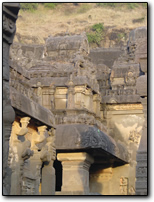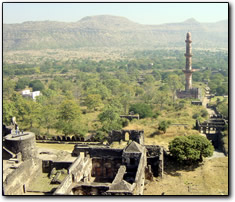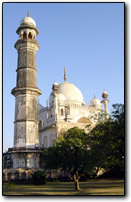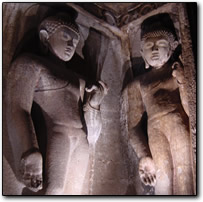
Ellora & Daulatabad
After a short, lurching bus ride from Aurangabad we arrived in Ellora just in time to see the sunrise over the nearby hills. Taking advantage of the early morning calm, we set off to explore the site. There are over thirty caves, some Buddhist, some Hindu and some Jain. Carved completely out of solid rock, the caves, some of them three levels high, are impressive. Inside are decorative pillars and niches with statues to Hindu and Buddhist deities.
 |
 |
The most interesting site, Kailasanatha, is a freestanding temple completely excavated from the surrounding rock. Although the exterior decoration is badly eroded, the sheer size and complexity of the temple is astounding. The entire structure has been excavated from the top down: spires, towers, columns, statues and all. Another nearby cave had ribbed interior arches like wooden beams carved out of the solid rock. The large Buddhist stupa inside had also once been part of the rock: the cave had been excavated around it, leaving no room for mistakes! As the morning wore on, the still blue-gray light turned yellow, and more and more noisy tourists appeared. Green chattering parrots hung from the cliff faces. We walked back to our hotel, watching black-faced monkeys beg as the tour bussed pulled into the parking lot.
 |
 |
Daulatabad, on the road back to Aurangabad, is an impressive hilltop fortress surrounded by barren scrub. During the 14 th century, Muhammad bin Tughluq marched the entire city of Delhi to the surrounding city. As soon as the emperor died, however, the city was abandoned, leaving an impressive fortress surrounded by a ruin. The citadel defenses are still intact, including a huge moat surrounded by cliffs and a dark, mazelike passageway through the inner walls.
 |
 |
